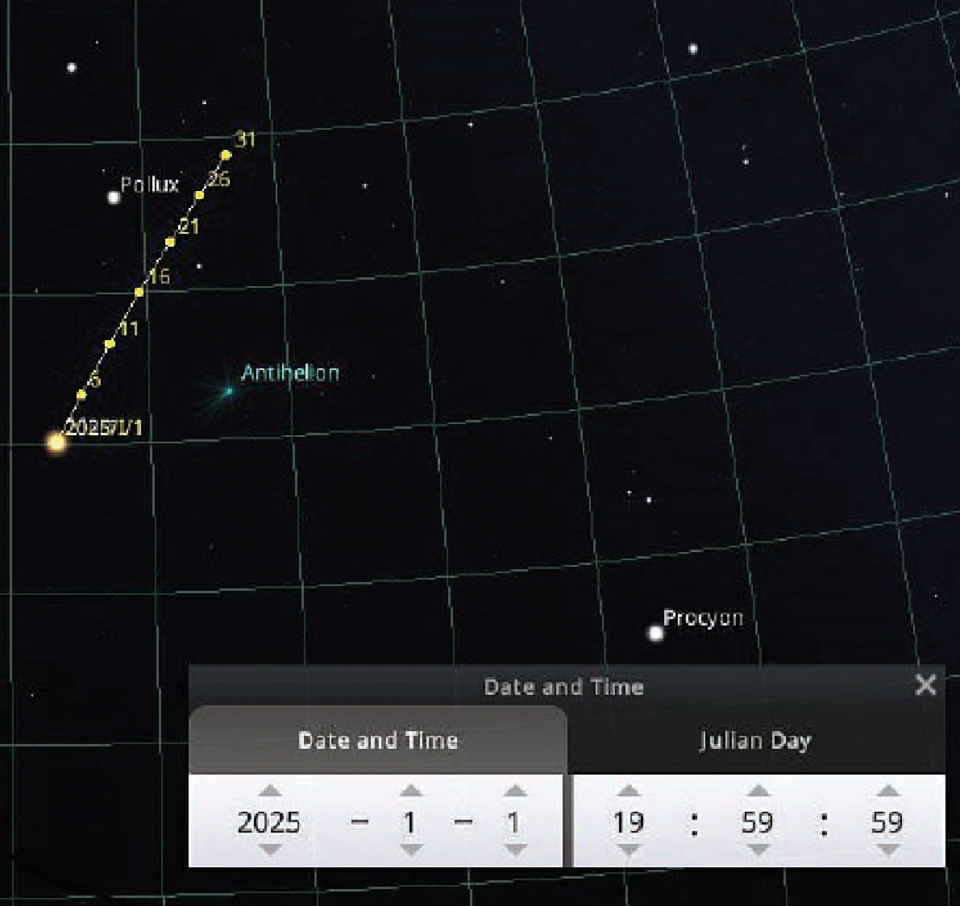The Quadrantid meteor shower will peak the night of Jan. 2/3. The radiant point is above the northern horizon all night, just left of the end of the handle of the Big Dipper, low in the north. While the Zenithal Hourly Rate (ZHR) is high, up to 120 per hour, the peak is fairly narrow, perhaps six hours or so, because we basically blow through the debris stream at right angles. There is, however, a chance of seeing some fireballs; think 2 seconds of bright as Venus, maybe leaving a trail. One thing about meteor observing especially in winter is that it’s like growing old; it’s not for sissies.
The solar system action continues Jan. 3 with a brilliant Venus at magnitude -4.5, a crescent Moon and a distinctly fainter-than-normal Saturn, roughly thirty degrees above the SSW horizon after sunset at 17:00. While this is a not-uncommon thing to see, there’s more to it than appears at first glance.
Through a telescope, Venus would appear to be a half-lit disc similar to a first-quarter Moon; it’s swinging around from behind the Sun, reaching maximum eastern elongation on Jan. 12. For the next four months or so, it will be visible in binoculars growing in diameter but less well lit until its conjunction March 22 after which it will reverse its size and phase changes as it appears in the morning sky. The tilt of Venus’s orbital plane means it passes about eight degrees north of the Sun at conjunction so it will be visible both in the evening in the NW after sunset and in the morning in the NE before sunrise for several days.
About 08:00 next morning, Jan. 4, the Moon occults Saturn for up to an hour. Unfortunately, we’re too far northwest to see that happen as they’re below the SE horizon. On Jan. 9, the Moon passes through the Pleiades cluster above and right of Orion, also known as the Seven Sisters. Unfortunately, the Moon will be bright enough to wash out all but the brightest nearby stars. The next night, it passes five degrees above and to the left of Jupiter and Jan. 13, it passes extremely close to Mars – about two arcminutes to the lower right of Mars. That’s about one-fifteenth the width of the Moon, if you were wondering.
The night of Jan. 12, Mars is also as close as it gets to Earth for this opposition. It distinctly elliptical orbit means that opposition at different times of the year changes its distance from Earth. This year, its retrograde motion is also easily visible from night to night: Jan. 1, mag. -1.3, well below and left of Pollux (in Gemini); Jan. 17, mag. -1.4, in line with Castor and Pollux, Jan. 29, mag. -1.1, to the right of Pollux at a right angle. (see screenshot attached) It’s easy to see why the Greeks called them “wanderers” when you have bright fixed stars nearby. That ancient Greek word spelled with English letters is “planetes.”
Jan. 17 also has the close pass of Venus and Saturn in the SW after sunset. By about 18:00, Saturn will be clearly visible although not as bright as we usually see. This is no illusion; its brightness does change over its orbit, the reason being that Saturn has seasons, just like Earth and Mars. Earth is tipped 23.4 degrees to its orbital plane, Mars 25.2 degrees and Saturn 26.7 degrees. Earth and Mars are basically spheres and other than their polar icecaps nothing much changes visibly when you see them tilted. The planet Saturn is basically similar except for one thing: it has very large, very reflective rings, about 175,000 miles across but less than a mile thick. Those rings orbit around Saturn’s equator and twice during Saturn’s roughly 30-year orbit, we get to see the rings edge-on, which means that we actually don’t see them at all. All we can see is the planet itself and it looks very much like a smaller, dimmer Jupiter with some faint moons. The sad part of it this year is that Saturn will be too close to the Sun to actually see it at all, rings or no rings. For the next 15 years we’ll see the south side of the rings and the planet until it does the same thing in reverse in 2039. I’m fairly sure I will have lost interest by then but younger observers are in for a treat.
The next SCAC monthly meeting will be at the Sechelt Library, Jan. 10, at 7 p.m. For details on the lecture topic and presenter please check the club website at:
sunshinecoastastronomy.wordpress.com.



